6 Ways to Optimize Your Signup Page and Preference Center for Maximum Engagement
November 12, 2020

Do you want a healthy list, full of subscribers who open your emails and stay engaged? Of course you do. That’s why it’s imperative you have a strong signup page and preference center.
Every job seeker has heard it a million times: You only get one chance to make a first impression. That classic career advice applies to marketers, too. Except instead of a job, you’re interviewing for someone’s time and money. A strong welcome series gives you an opportunity to demonstrate your brand values, get to know a new customer, and hopefully turn them into a loyalist. And it’s likely that welcome series was essentially born on a signup page.
Welcome emails have an unusually high open rate — about 86% higher than other promotional emails. That makes sense. By signing up, your new subscriber just told you loud and clear that they want to hear from your brand. It’s natural for that interest to wane, which is where the preference center comes in.
These two pages are crucial in nurturing and maintaining engagement. Here are six tactics for optimizing them:
1. Make Your Intentions Clear
As a marketer, you naturally want as much data as possible. Data assists segmentation and enables you to create robust profiles on each customer, without which true personalization is impossible. Unfortunately, the customer may not see it that way. If you’re asking people for their information, make sure they understand why.
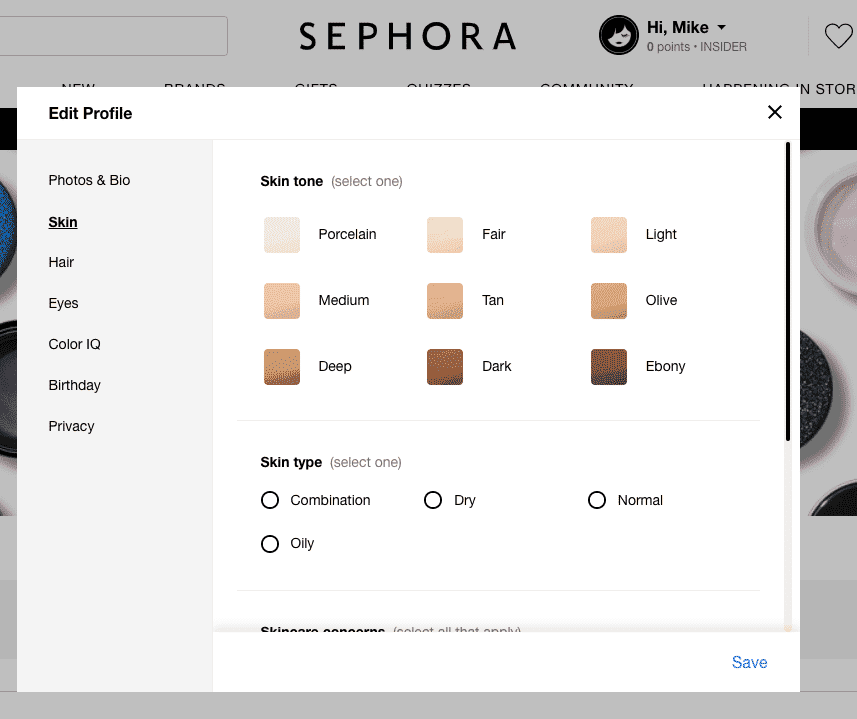
Sephora asks new subscribers a lot of questions, some of which would be inappropriate in another context. However, by asking about a customer’s race in this instance helps the beauty giant hone its top-tier personalization. Knowing a customer’s skin tone, Sephora is able to recommend relevant products.
2. Ask Yourself, “Do I Need to Ask?”
On the flip side, if you’re a media brand with content that isn’t necessarily geared toward men or women, someone may not understand why you’re asking their gender. That moment of hesitation could be just enough time for them to lose interest. (This also applies to the triggered email verification, by the way; plenty of people just can’t be bothered to click.)
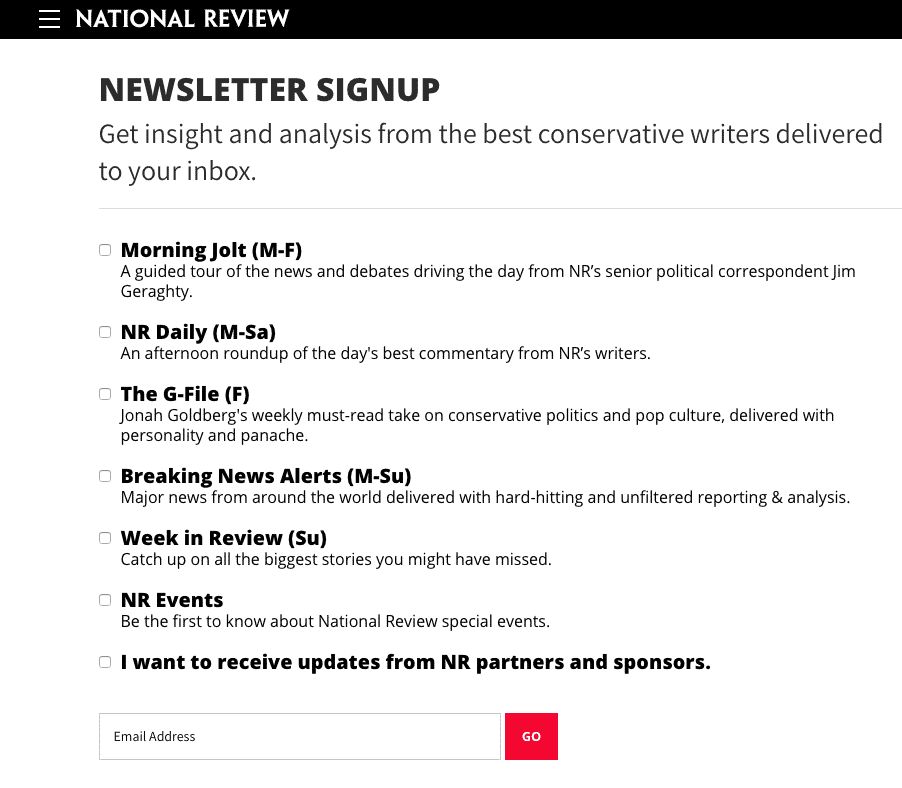
Remember that not all segments require consumers to answer questions. For example, acquisition source — did the subscriber simply sign up or is this a post-purchase sign-up? — is useful for segmentation, as is interest data. National Review increased clickthrough rate by 142%, thanks in part to improved personalization. And yet, notice how few questions the publisher asks new subscribers. The onus isn’t on readers to explicitly share their interests; National Review gleans that from their onsite and email behavior.
3. Have a Preference Center
Surveying more than 2,500 consumers, Alliance Data found that 69% want some control over their email frequency. Alliance Data also discovered that just 10% of retail marketers offer that as an option. That’s right. preference centers are so often overlooked that the first, lowest-hanging fruit best practice is to simply have one at all.
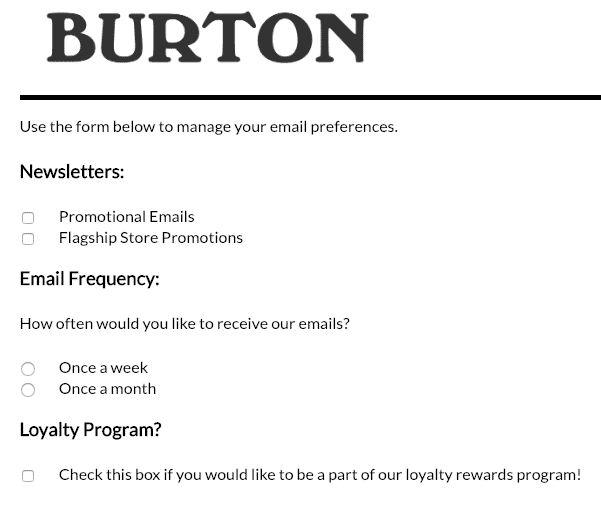
Burton sells snowboards and gear, outerwear, luggage and camping equipment. None of those are the types of products the average person would purchase every day. Therefore, Burton keeps its email frequency to weekly and monthly, giving subscribers a choice. The preference center also differentiates between general promotional emails and flagship store promotions, while also making it simple to join the loyalty program. Notice that Burton also says why it’s asking your birthday.
4. Keep Your Preference Center Simple…
Anyone with a Netflix account (or their old roommate’s ex-girlfriend’s mom’s password, whichever) is familiar with that feeling where you’re so overwhelmed with options, you ultimately choose… nothing. Choice paralysis is present in preference centers, too, albeit on a much smaller scale.

Provide a preference center and keep things high-level. Refinery29 has more 20 different newsletters about everything from news to astrology to The Bachelor. Receiving all of them would quickly overwhelm most subscribers. Refinery29 simplifies the signup process by outlining what each newsletter is and how frequently it’s sent.
5. …and Easy to Update
It’s not always that someone doesn’t want to hear from you anymore. They may just not want to hear from you as often, which is why a preference center is a must. Sure, you’d rather someone gets all your emails. But isn’t it better that they unsubscribe to all but one, rather than opt out across the board?
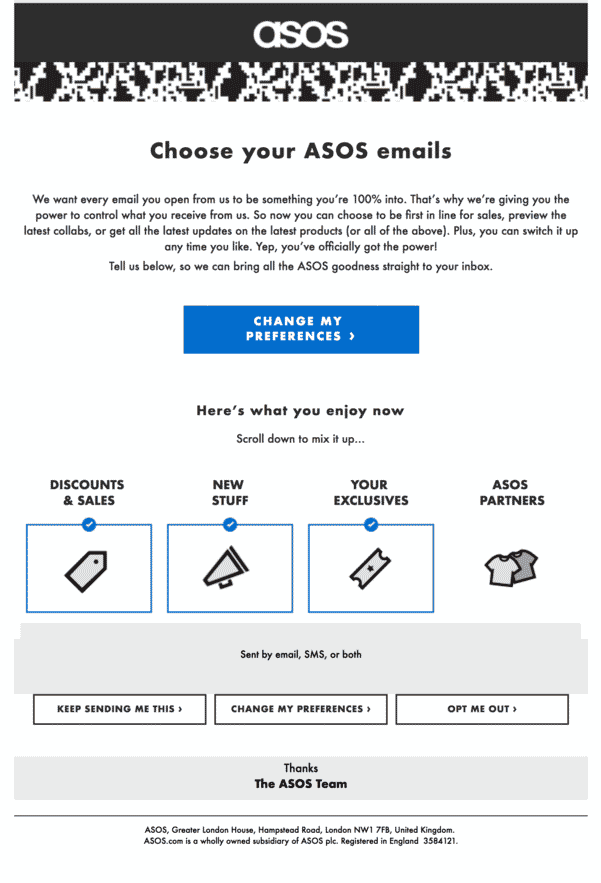
ASOS does this well. The retailer’s marketing communications, both email and mobile messaging, fall into four different categories. Switching subscription preferences is seamless. At the same time, ASOS nails the language, letting shoppers know that this preference center is ultimately there to ensure the best possible customer experience for them.
6. Accept Opt-Outs
Per the CAN-SPAM Act, failure to include an unsubscribe link in your emails is illegal, punishable by a Federal Trade Commission-enforced fine of up to $16,000. Per email. How many people are on that list, again? You can hide your unsubscribe link in the fine print, but you shouldn’t. If the experience of unsubscribing is frustrating, people may not bother. They’ll remain on your list, but they certainly won’t be engaged, hurting all your metrics.
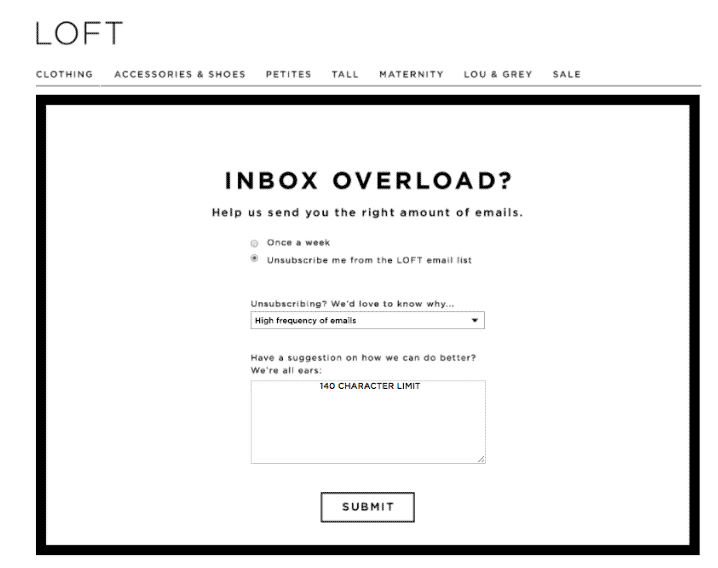
Subscribers are going to opt out; find out why! We like the way LOFT went beyond the typical options — high frequency, not relevant — and included a blank field, so subscribers could share any other reason the brand didn’t think of and improve things in the future. Just be sure to give people the option to unsubscribe from your marketing emails. That way, you’re still able to send emails like order confirmations and password reset notifications, while still maintaining CAN-SPAM compliance.
For help improving your sign-up pages and preference center, please reach out to your Customer Success Manager. If you haven’t worked with Marigold Engage by Sailthru before, click here for a demo.
The State of Brand Loyalty in the U.S. in 2023
Related



